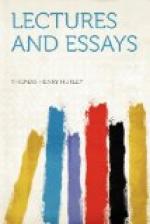whether it is not a
happy inconsistency by which they continue to
believe the Scriptures
while they reject the Church[62] (p. liii).
Again, I invite Anglican orthodoxy to consider this passage:—
the narrative of the combats of St. Antony with evil spirits, is a development rather than a contradiction of revelation, viz. of such texts as speak of Satan being cast out by prayer and fasting. To be shocked, then, at the miracles of Ecclesiastical history, or to ridicule them for their strangeness, is no part of a scriptural philosophy (pp. liii-liv).
Further on, Dr. Newman declares that it has been admitted
that a distinct line can lie drawn in point of character and circumstance between the miracles of Scripture and of Church history; but this is by no means the case (p. lv) ... specimens are not wanting in the history of the Church, of miracles as awful in their character and as momentous in their effects as those which are recorded in Scripture. The fire interrupting the rebuilding of the Jewish Temple, and the death of Arius, are instances, in Ecclesiastical history, of such solemn events. On the other hand, difficult instances in the Scripture history are such as these: the serpent in Eden, the Ark, Jacob’s vision for the multiplication of his cattle, the speaking of Balaam’s ass, the axe swimming at Elisha’s word, the miracle on the swine, and various instances of prayers or prophecies, in which, as in that of Noah’s blessing and curse, words which seem the result of private feeling are expressly or virtually ascribed to a Divine suggestion (p. lvi).
Who is to gainsay our ecclesiastical authority here? “Infidel authors” might be accused of a wish to ridicule the Scripture miracles by putting them on a level with the remarkable story about the fire which stopped the rebuilding of the Temple, or that about the death of Arius—but Dr. Newman is above suspicion. The pity is that his list of what he delicately terms “difficult” instances is so short. Why omit the manufacture of Eve out of Adam’s rib, on the strict historical accuracy of which the chief argument of the defenders of an iniquitous portion of our present marriage law depends? Why leave out the account of the “Bene Elohim” and their gallantries, on which a large part of the worst practices of the mediaeval inquisitors into witchcraft was based? Why forget the angel who wrestled with Jacob, and, as the account suggests, somewhat over-stepped the bound of fair play, at the end of the struggle? Surely, we must agree with Dr. Newman that, if all these camels have gone down, it savours of affectation to strain at such gnats as the sudden ailment of Arius in the midst of his deadly, if prayerful,[63] enemies; and the fiery explosion which stopped the Julian building operations. Though the words of the “Conclusion” of the “Essay on Miracles” may, perhaps, be quoted against me, I may express my satisfaction




